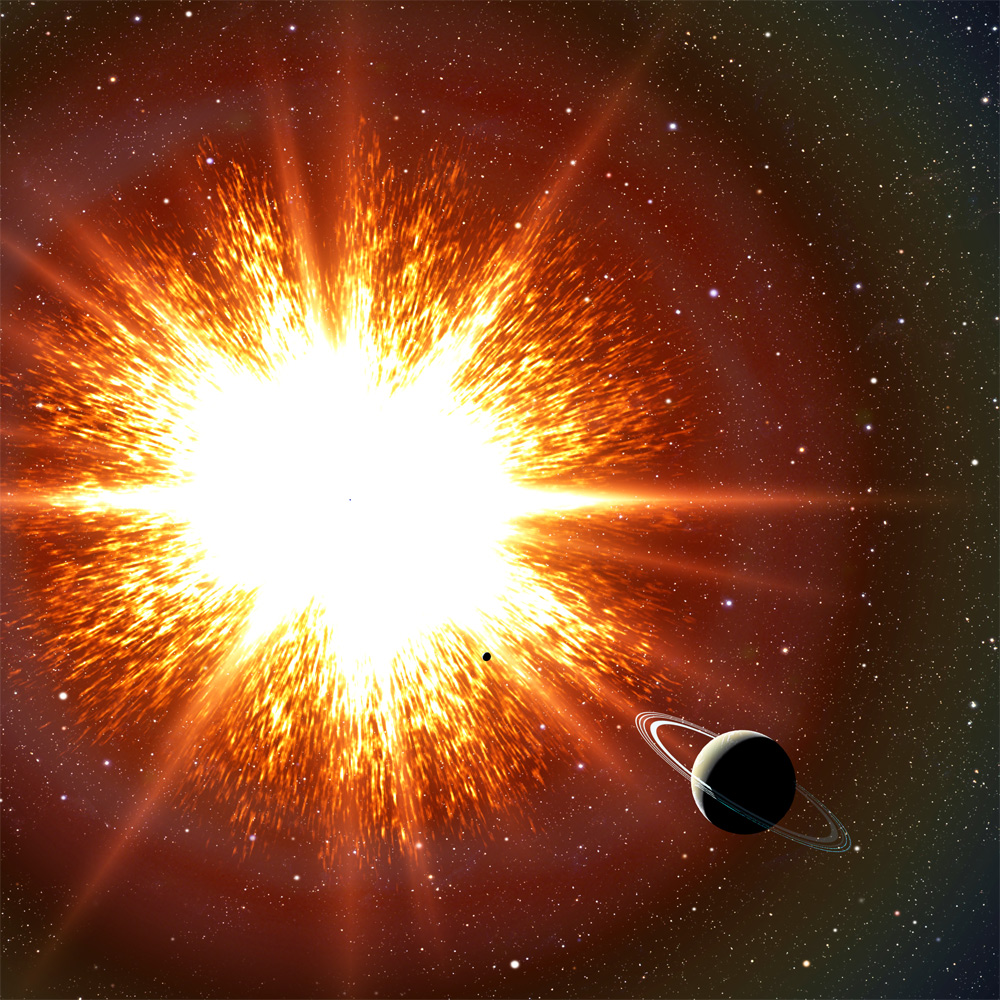Hunt Is on for Ticking 'Time Bomb' Stars

Thousands of ticking time bomb stars set to explode at any moment are hidden throughout our galaxy, according to a new study.
When massive stars reach the end of their lives, they can explode in fiery fits called supernovas. Astronomers calculate that about three stars explode in a specific category of supernova called Type 1a every thousand years in the Milky Way. That means that within a few thousand light-years of Earth there should be dozens of stars on the verge of exploding.
Yet while scientists know these stars are out there, they've had trouble so far identifying which stars are nearing the explosion point. But the new research offers hope of finding the ticking time bombs more easily by looking for features that had previously been ignored. [Photos of Great Supernova Explosions]
"We haven’t found one of these 'time bomb' stars yet in the Milky Way, but this research suggests that we've been looking for the wrong signs," astrophysicist Rosanne Di Stefano of the Harvard-Smithsonian Center for Astrophysics in Cambridge, Mass., said in a statement. "Our work points to a new way of searching for supernova precursors."
Unsolved mysteries
Di Stefano and her colleagues offer a new model for how these stars explode that could explain some niggling unsolved mysteries.
The reigning theory behind Type 1a supernovas is that they are caused when old, dense stars called white dwarfs slowly steal mass from nearby companion stars until they reach a tipping point, becoming too massive to fight against the inward pull of gravity, and collapse. This weight limit, about 1.4 times the mass of the sun, is called the Chandrasekhar mass.
Get the Space.com Newsletter
Breaking space news, the latest updates on rocket launches, skywatching events and more!
But if that is the case, scientists would expect to find these companion stars left over after supernovas fade from sight. They also predict small amounts of hydrogen and helium gas would have been left nearby, representing material that wasn't sucked into the white dwarf, or that was dislodged from the companion in the explosion.
Yet none of these smoking gun clues appear to be present around known supernovas.
Slowing down
Perhaps, Di Stefano and her colleagues propose, white dwarfs are able to reach the Chandrasekhar mass but postpone the inevitable by spinning quickly.
As a star gobbles up more mass, it also increases its angular momentum, which causes it to spin up. This increased spin can act as a stabilizing force, allowing the white dwarf to tip the scales over the Chandrasekhar mass without exploding.
After the star stops eating its neighbor's mass, however, it will gradually slow down, and eventually succumb to gravity in a supernova.
Yet the spinning effect could give the star a buffer, perhaps of up to a billion years, between when the white dwarf stops accreting mass, and when it explodes. During this lag, the leftover gas from the companion star may dissipate, and the companion could evolve into a white dwarf itself.
Bomb squad
The new model suggests a new tack for hunting impending supernovas. According to the research, astronomers could start to look for white dwarf stars that have already reached the Chandrasekhar limit, and are in the process of spinning down. [Video: Supernovas: Destroyers and Creators]
"We don’t know of any super-Chandrasekhar-mass white dwarfs in the Milky Way yet, but we're looking forward to hunting them out," said co-author Rasmus Voss of Radboud University Nijmegen in the Netherlands.
The researchers reported their findings in the Sept. 1 issue of The Astrophysical Journal Letters.
You can follow SPACE.com senior writer Clara Moskowitz on Twitter @ClaraMoskowitz. Follow SPACE.com for the latest in space science and exploration news on Twitter @Spacedotcom and on Facebook.
Join our Space Forums to keep talking space on the latest missions, night sky and more! And if you have a news tip, correction or comment, let us know at: community@space.com.

Clara Moskowitz is a science and space writer who joined the Space.com team in 2008 and served as Assistant Managing Editor from 2011 to 2013. Clara has a bachelor's degree in astronomy and physics from Wesleyan University, and a graduate certificate in science writing from the University of California, Santa Cruz. She covers everything from astronomy to human spaceflight and once aced a NASTAR suborbital spaceflight training program for space missions. Clara is currently Associate Editor of Scientific American. To see her latest project is, follow Clara on Twitter.









